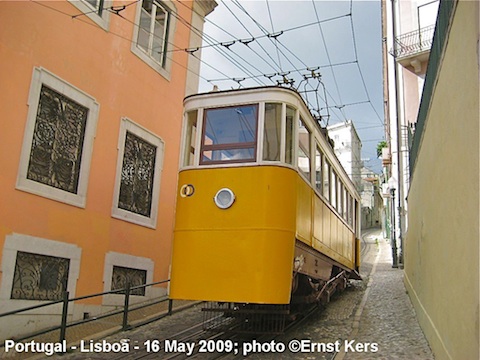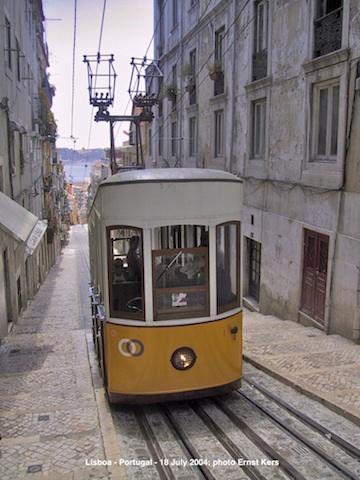Cable trams
The steep inclines of the Lisbon hills hindered the development of the mule tram network. A number of imporant relations could not be tackled by the mules. Because of that three cable tramlines, three funiculars and three vertical lifts were constructed. The cable tramlines disappeared because of the electrifcation of the Carris network. The funiculars still all exist. Of the vertical lifts one remains. These cable trams, funiculars and vertical lifts were not operated by Carris, but by separate companies, in most cases the "(Nova) Companhia dos Ascencores Mecânicos de Lisboa". Carris acquired the majority of the shares of the NCAML in 1912 and absorbed the company in 1926. For all projects the engineer Raúl Mesnier de Ponsard played the key role for the design as well as for promoting the initiatives for construction.Estrela cable tram
The Estrela cable tram was opened on 14 August 1890. The line, with a length of 1.7 km, did have its termini at Praça de Camões and Largo de Estrela. At the latter the depot and winding were located. A turntable in the street did give acces to the depot and was also used to turn the cars. At Camões a terminal loop was used.The line, constructed by the Maschinenfabrik Esslingen, did have a gauge of 90 cm, side-slot and side-jaw cable. There were four small single-ended cars numbered 1, 3, 4 & 8 and two gripper & trailer pairs, of which the trailers did have the numbers 5 & 6. It is not known if the numbers 2 & 7 were used for the gripper cars or these numbers did belong to additional cars.
The line closed on 3 July 1913. On 1 March 1914 the replacing electric tramline 28 was opened.
Graça cable tram
The Graça cable tram was opened on 27 February 1893 between Rua da Palma (Martim Moniz) and Largo da Graça. The length of the line was 730 m and the height difference 75 m. The gauge was 90 cm with interlaced tracks. The two inner rails coincided with the cable slots for the bottom-grips.There were two types of cars, probably two of both types. All cars were double-ended, as stub termini were used. The depot was located at the Graça terminus.
The line was closed in 1909. The replacing electric tramline 12 was opened on 1 January 1915. However the upper terminus was changed for São Tomé instead of Graça.
São Sebastião cable tram
This line, operated by the "Companhia de Viação Funicular" was inaugurated on the 15th of January 1899. It started in Largo de São Domigos and ran via Rua de Santo Antão, Rua das Pretas and Largo Andaluz to Largo de São Sebastião da Pedreira. Photos or data about the rolling stock are unknown. Already by 1903 operations were ceased.Lavra funicular
 The
Lavra funicular was opened on 19 April 1884. The original
cars were using the water counterbalance system for
propulsion. After some time the line was converted to steam
power. In 1915 electricity did replace the steam.
The
Lavra funicular was opened on 19 April 1884. The original
cars were using the water counterbalance system for
propulsion. After some time the line was converted to steam
power. In 1915 electricity did replace the steam.In 1930 the line was converted. Both cars are motorized and electric connected by two of the overhead wires. The other two overhead wires are for the power supply. The driver of the ascending car does regulate the speed.
- Length: 188 m
- Height difference: 43 m
Glória funicular The
funicular in the Calçada da Glória was
opened
on 25 October 1885. The original cars were of
double-deck
construction using the water counterbalance system
for
propulsion. To reduce the cost a steam pump was
installed
after some time to re-use the water. For (emergency)
braking
a rack rail and cogwheel were used. Since 1914
electricity
was used. The
funicular in the Calçada da Glória was
opened
on 25 October 1885. The original cars were of
double-deck
construction using the water counterbalance system
for
propulsion. To reduce the cost a steam pump was
installed
after some time to re-use the water. For (emergency)
braking
a rack rail and cogwheel were used. Since 1914
electricity
was used.In 1930 the line was converted. Both cars are motorized and electric connected by two of the overhead wires. The other two overhead wires are for the power supply. The driver of the ascending car does regulate the speed.
|
Bica funicular
 The
funicular in the Rua da Bica was opened in June 1892. The
original water counter-balance system was replaced in 1896
by a steam winding engine. In 1913 this was replaced for an
electric engine. However a serious accident on 10 February
1913 forced closure until 1923.
The
funicular in the Rua da Bica was opened in June 1892. The
original water counter-balance system was replaced in 1896
by a steam winding engine. In 1913 this was replaced for an
electric engine. However a serious accident on 10 February
1913 forced closure until 1923.- Length: 283 m
- Height difference: 45 m
Vertical lifts
The first vertical lift was the Elevador do Chiado. It was constructed inside an existing building and connected the Rua do Carmo with the Rua do Crucifixo. It was opened on the 15th of February 1892 and closed in 1912.The second vertical lift on the scene was constructed on the Largo do Município. A foot-bridge connected the top with the Largo da Biblioteca. It was opened on 12 January 1897 and know as the Elevador do Município, Elevador da Biblioteca or Elevador de São Julião. It was closed in 1915.
The last lift was opened on 10 July 1902 and is called Elevador de Santa Justa or Elevador do Carmo. This lift still exists. It stands in Rua de Santa Justa and the top is with a foot-bridge connected with Largo do Carmo.